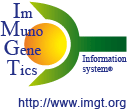IGHG CH properties and antibody engineering
Excerpt of: Lefranc M-P. IMGT® immunoglobulin repertoire analysis and antibody humanization.
In: Alt, F.W, Honjo, T, Radbruch A. and Reth, M. (Eds.), Molecular Biology of B cells, Second edition, Academic Press, Elsevier Ltd, London, UK, Chapter 26, 2014, PP. 481-514.
dx.doi.org, ISBN : 978-0-12-397933-9. LIGM: 438
page 510 (source above to be quoted)
4.4.4.1 N-linked glycosylation site CH2 N84.4
A N-linked glycosylation site is present in the CH2 domain of the constant region of the human IG heavy chains of the four IgG isotypes. The N-linked glycosylation site belongs to the classical N-glycosylation motif N-X-S/T (where N is asparagine, X any amino acid except proline, S serine, T threonine) and is defined as CH2 N84.4. As shown in the IMGT Collier de Perles, this asparagine is localized at the DE turn. The IMGT unique numbering has the advantage of identifying the C domain (here, CH2) and, in the domain, the amino acid and its localization (here, N84.4) which can be visualized in the IMGT Collier de Perles and correlated with the 3D structure (80).
4.4.4.2 Interface ball-and-socket-like joints
The interface between the CH2 and CH3 domains in 3D structures of Homo sapiens IGHG2 Fc was recently analysed and compared with the interface in 3D structures of IGHG1 Fc (101). This study revealed that in all Fc of gamma chains the movement of the CH2 results from a pivoting around a highly conserved ball-and-socket-like joint (101), in which, using the IMGT numbering, the CH2 L15 side chain (last position of the A strand, next to the AB turn) (the ball) interacts with a pocket (the socket) formed by CH3 M107, H108, E109 and H115 (FG loop) (80). These amino acids are well conserved between the gamma isotypes and the IGHG genes and alleles except for IGHG3 H115 that shows a polymorphism associated to different G3m allotypes (74). This ball-and-socket-like joint is a structural feature similar but reversed to that previously described at the VH and CH1 domain interface (102), in which the VH L12, T125 and S127 form the socket whereas the CH1 F29 and P30 (BC loop) form the ball.
4.4.4.3 Knobs-into-hole CH3 T22 and Y86
The knobs-into-holes methodology has been proposed for obtaining bispecific antibodies (103). The aim is to increase interactions between the CH3 domain of two gamma1 chains that belong to antibodies with a different specificity. Two amino acids, CH3 T22 (B strand) and Y86 (E strand), which belong to the [ABED] sheet, at the interface of the two Homo sapiens IGHG1 CH3 domains (80), were selected for amino acid changes. Interactions of these two amino acids are described in 'Contact analysis' in IMGT/3Dstructure-DB (8-10). The knobs-into-holes methodology consists into an amino acid change on one CH3 domain (T22>Y) that creates a knob, and another amino acid change on the other CH3 domain (Y86>T) that creates a hole, thus favoring increased interactions between the CH3 of the two gamma1 chains at both positions 22 and 86 (103) (IMGT® http://www.imgt.org, IMGT Biotechnology page > Knobs-into-holes).
(8) Kaas, Q., Ruiz, M., and Lefranc, M.-P. (2004). IMGT/3Dstructure-DB and IMGT/StructuralQuery, a database and a tool for immunoglobulin, T cell receptor and MHC structural data. Nucl Acids Res. 32, D208-210.
(9) Ehrenmann, F., Kaas, Q., and Lefranc, M.-P. (2010). IMGT/3Dstructure-DB and IMGT/DomainGapAlign: a database and a tool for immunoglobulins or antibodies, T cell receptors, MHC, IgSF and MhcSF. Nucl Acids Res. 38, D301-307.
(10) Ehrenmann, F., and Lefranc, M-P. (2011). IMGT/3Dstructure-DB: Querying the IMGT Database for 3D Structures in Immunology and Immunoinformatics (IG or Antibodies, TR, MH, RPI, and FPIA). Cold Spring Harb Protoc. 6, 750-761. pii: pdb.prot5637. doi: 10. 1101/pdb.prot5637.
(74) Lefranc, M.-P., and Lefranc, G. (2012). Human Gm, Km and Am allotypes and their molecular characterization: a remarkable demonstration of polymorphism. In: Immunogenetics (F. Christiansen and B. Tait, Eds.), Chap. 34. Humana Press, Springer, New York. Methods Mol Biol. 882, 635-680.
(80) Lefranc, M.-P. How to use IMGT® for therapeutic antibody engineering. In: Handbook of therapeutic antibodies (S. Dübel and J. Reichert, Eds.) 2nd ed. Wiley.
(101) Teplyakov, A., Zhao, Y., Malia, T.J., Obmolova, G., and Gilliland, G.L. (2013). IgG2 Fc structure and the dynamic features of the IgG CH2-CH3 interface. Mol. Immunol. 56, 131-139.
(102) Lesk, A.M., and Chothia, C. (1988). Elbow motion in the immunoglobulin involves a molecular ball-and-socket joint. Nature 335, 188-190.
(103) Ridgway, J.B., Presta, L.G., and Carter, P. (1996). Knobs-into-holes' engineering of antibody CH3 domains for heavy chain heterodimerization. Prot Eng. 9, 617-621.
- Amino acid positions involved in ADCC, ADCP, CDC, half-life and half-IG exchange (IMGT Education>Tutorials)
- Glycosylation (IMGT Lexique)
- Knobs-into-holes amino acid changes (The IMGT Biotechnology page)



